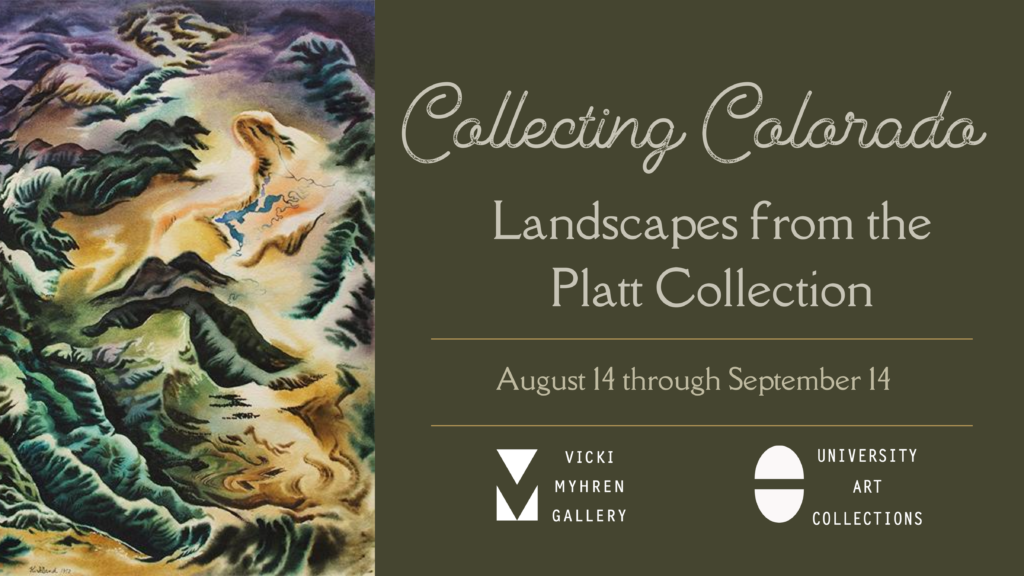Collecting Colorado
Collecting Colorado
Landscapes from the Platt Collection

On view August 14 through September 14, 2025
Artists have long been drawn to Colorado for its colorful scenery, breathtaking mountain vistas, and clear skies. Over several decades, Constance “Connie” Platt assembled an expansive collection celebrating artistic responses to this remarkable landscape. Featuring a wide range of artists, styles, and media, Collecting Colorado traces the evolution of landscape art in the state from the late nineteenth century to the present, underscoring the enduring power of the natural environment as a source of inspiration.
This exhibition is dedicated to Connie Platt. Earlier this year, she donated her collection of more than ninety artworks to the University Art Collection. In doing so, she ensured the lasting impact of these artworks and their availability to the public. Connie’s generosity and dedication to Colorado art will live on in this collection, enriching future possibilities for display, research, and public engagement.















Photos by Wes Magyar


Top: Charles Partridge Adams, Sunset Near the Platte, Late October, 1910. Watercolor on paper.
Bottom: Charles Partridge Adams, Fish Creek, Estes Park, CO, 1905. Oil on canvas.
Photos by Wes Magyar
Charles Partridge Adams (1858 – 1942)
By Tiffany Jessen (DU ’27)
Charles Partridge Adams was born in 1858 in a small town in Massachusetts. In 1876, he moved to Colorado with his younger sister in hopes that the different climate would help her tuberculosis. Surrounded by Colorado’s growing art scene, Adams taught himself to paint, meeting other artists, and gaining experience working in a tight-knit community. His paintings were featured for the first time in a Denver gallery in 1886, a collection of oil paintings depicting Colorado landscapes. In 1893, Adams opened his own private gallery space where he began using a new, cheaper medium of watercolor. With watercolors, he played with light and captured small details of the expansive landscape. This is seen in his painting Mountains and Creek (1897), with tiny pebbles included alongside large mountains, no details left to spare.
Many of Adams’ early paintings reveal the influence of impressionism. When painting with oils, he used thick, rich brushstrokes, a technique known as “impasto.” Adams’ paintings removed characters or subjects, another trait of impressionism, focusing on using vivid and diverse ranges of colors that come together to create craggy hills and emotion-provoking landscapes. When using watercolors, his details were so fine that viewers had to get close to the painting to see it all. Given his expertise in both mediums, some called him the “best painter of mountains.”
One of Adams’ favorite spots to paint was in Estes Park. It was in this mountain town that he created some of the featured artworks in the exhibit such as Moraine Park, Estes Park, CO (1910), and Estes Park Study (1905). Adams bought a house in Estes Park known as “The Sketchbox,” which became his studio and a refuge for other Western artists seeking out mountain landscapes. Later in life, Adams moved to California for his health and remained there until his death in 1942. Though he shifted to painting coastal scenes, accounts say that he yearned to paint his beloved mountain instead. Adams remains one of Colorado’s most well-known and passionate painters, and one of the finest of his time.
Angie Coleman
By Emily Maiwat (DU ’26)
Angie Coleman is a celebrated American printmaker and painter best known for her richly colored woodblock prints that capture the beauty of the mountainous landscapes of the American Southwest. A long-time resident of Taos, New Mexico, Coleman draws much of her artistic inspiration from her frequent hikes and camping excursions throughout the mountains of New Mexico and Colorado, the regions that inspire both the subject matter and emotional tone of her work.
Originally from the Chicago area, Coleman later earned her degree from the California College of Arts and Crafts in Oakland, California. After moving to Taos, she became deeply rooted in the local art scene while also maintaining a broader national presence through exhibitions and museum collections. Her working studio and gallery in downtown Taos serves as both a creative space and a venue for connecting directly with viewers and collectors.
While she also creates works in oil and pastel, Coleman is primarily recognized for her masterful color woodblock prints. Employing the reduction method, a technique where a single block is carved and printed in layers of color, she builds her images layer by layer. The results are prints that are bold and serene, often featuring the forests, peaks, skies, and changing seasons of the Rocky Mountain region.
Coleman’s imagery is not just representational but infused with a deep reverence for the natural world. Her scenes evoke the stillness of aspen groves, the golden light of autumn, or the crisp air of high altitudes, creating an emotional experience that goes beyond the visual. Works such as Santa Barbara Aspens, which earned the Purchase Award from the Harwood Museum in 2007, exemplify her ability to translate personal experience into universally resonant landscapes.
Through her dedication to craft and her deep connection to the natural world, Angie Coleman has established herself as a significant voice in contemporary American printmaking, with Colorado and New Mexico’s dramatic terrain playing a key role in the vision and vitality of her art.

Angie Coleman, Fall, South San Juans, 2009. Screen print (6/12).
Photo by Wes Magyar
